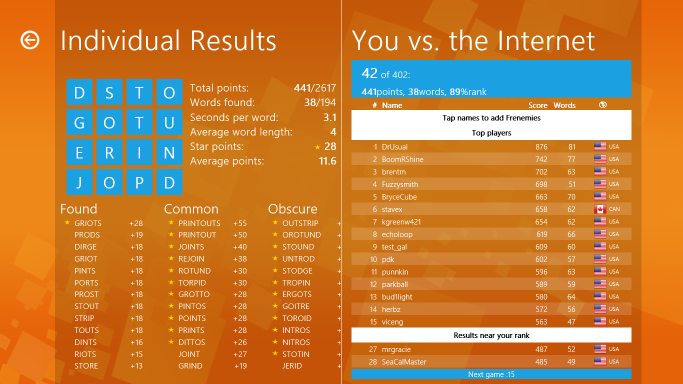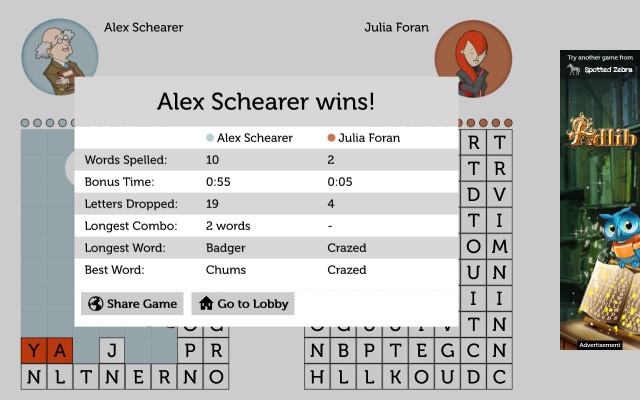Scramble Legends has evolved considerably since its inception. From the get go I knew I wanted to make a game that combined the core mechanic of Adlib with competitive, multiplayer gameplay. Along the way, I needed to figure out exactly how that would work in practice.
Arguably the most important question I needed to answer was what the end game condition should be. In Adlib the game ends when letters overflow the top of your board. However I found when playing against a friend that that condition took much too long to occur. While it’s acceptable in a single player game for a play session to last thirty minutes or an hour I felt that was too long for an asynchronous multiplayer game. Ideally, I wanted a match to last about fifteen or twenty minutes from start to finish.
Pre-designed Limits
Limiting a play session to a given number of turns, time, or score was an obvious way to achieve my target game duration. You could play the game as you did in single player, and compare your performance with your opponent’s at the end. This approach comes with a number of advantages:
- Proven track record in games such as Wordament
- Scales to support as many opponents as you want
- Relatively easy to implement

All of that being said I opted not to go down this route. Why? Because I wanted you to be able to interact with your opponent and this end condition encouraged a sort of solipsistic play style. With Scramble Legends, I want to create a more intense experience which a solitary play style can’t deliver.
Bury your Opponent
Setting aside the previous idea and expanding on the original end game condition, I asked myself, what if you competed to bury your opponent completely? I liked this idea right away first because it dovetailed nicely with the original Adlib and second because it opened up the possibility for interesting interaction between you and your opponent. I also identified some other benefits:
- Emphasizes skillful play by putting end game condition in your hands
- Gives you the satisfaction of actively beating your opponent
- Opens up possibility for multiple play styles
All well in good, but how would you fill your opponent’s board? By spelling words of course! Or at least that’s what I thought. However it turned out that balancing a player’s attack strength was a thorny design problem in its own right – but that’s a story we’ll explore another time.

In the end, you try to bury your opponent in Scramble Legends. I’m quite excited about this end game condition and feel it offers the most skillful and exciting gameplay.
- User Interface: a look at how the user interface was designed
- Avatar Style: follow the evolution of Scramble Legends' art style
- Making the Avatars: guest post by Kyle McGill artist for Scramble Legends
- Avatar Design: learn how the avatar art style was finalized
- End Game Condition: explore the thought process behind the game's end game condition
- Attack Design: understand why Scramble Legends is all about burying your opponent
- Overdrive Mode: a look at the design and technical considerations behind this special game mode
- Sound Design: guest post by David Kizale sound designer for Scramble Legends

